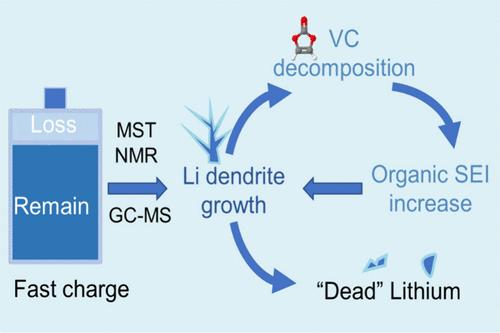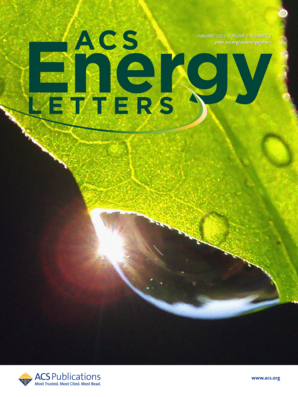Quantitative Analysis of the Coupled Mechanisms of Lithium Plating, SEI Growth, and Electrolyte Decomposition in Fast Charging Battery
IF 18.2
1区 材料科学
Q1 CHEMISTRY, PHYSICAL
引用次数: 0
Abstract
Lithium ion battery (LIBs) degradation under fast-charging conditions limits its performance, yet systematic and quantitative studies of its mechanisms are still lacking. Here, we used dynamic electrochemical impedance spectroscopy (DEIS), mass spectrometry titration (MST), nuclear magnetic resonance (NMR), and gas chromatography–mass spectrometry (GC-MS) to reveal the degradation mechanisms in LiFePO4//graphite batteries at different charging rates. DEIS reveals three distinctive lithium plating processes: no lithium plating (1 and 2 C), lithium nucleation and growth (3 C), and lithium dendrite growth (4 to 6 C). In aged batteries, Li/LixC6 (x < 1), organic SEI components, and VC decomposition increase exponentially with increasing charging rate, while inorganic SEI increases slowly. Lithium dendrite growth (trigger mechanism) under fast charging conditions selectively induces VC decomposition and organic SEI formation (coupling mechanism) and results in lithium dendrite detachment forming “dead” lithium (accompanying mechanism), which together lead to rapid battery degradation at high charging rates.

快速充电电池中的镀锂、SEI 生长和电解质分解耦合机制的定量分析
锂离子电池(LIBs)在快速充电条件下的降解限制了其性能,但目前仍缺乏对其机理的系统性定量研究。在此,我们使用动态电化学阻抗谱(DEIS)、质谱滴定(MST)、核磁共振(NMR)和气相色谱-质谱(GC-MS)揭示了磷酸铁锂/石墨电池在不同充电速率下的降解机制。DEIS 揭示了三种不同的锂电镀过程:无锂电镀(1 和 2 C)、锂成核和生长(3 C)以及锂枝晶生长(4 至 6 C)。在老化电池中,锂/LixC6 (x < 1)、有机 SEI 成分和 VC 分解随着充电速率的增加而呈指数增加,而无机 SEI 增加缓慢。在快速充电条件下,锂枝晶的生长(触发机制)会选择性地诱导 VC 分解和有机 SEI 的形成(耦合机制),并导致锂枝晶脱落,形成 "死 "锂(伴随机制),这共同导致了电池在高充电速率下的快速降解。
本文章由计算机程序翻译,如有差异,请以英文原文为准。
求助全文
约1分钟内获得全文
求助全文
来源期刊

ACS Energy Letters
Energy-Renewable Energy, Sustainability and the Environment
CiteScore
31.20
自引率
5.00%
发文量
469
审稿时长
1 months
期刊介绍:
ACS Energy Letters is a monthly journal that publishes papers reporting new scientific advances in energy research. The journal focuses on topics that are of interest to scientists working in the fundamental and applied sciences. Rapid publication is a central criterion for acceptance, and the journal is known for its quick publication times, with an average of 4-6 weeks from submission to web publication in As Soon As Publishable format.
ACS Energy Letters is ranked as the number one journal in the Web of Science Electrochemistry category. It also ranks within the top 10 journals for Physical Chemistry, Energy & Fuels, and Nanoscience & Nanotechnology.
The journal offers several types of articles, including Letters, Energy Express, Perspectives, Reviews, Editorials, Viewpoints and Energy Focus. Additionally, authors have the option to submit videos that summarize or support the information presented in a Perspective or Review article, which can be highlighted on the journal's website. ACS Energy Letters is abstracted and indexed in Chemical Abstracts Service/SciFinder, EBSCO-summon, PubMed, Web of Science, Scopus and Portico.
 求助内容:
求助内容: 应助结果提醒方式:
应助结果提醒方式:


